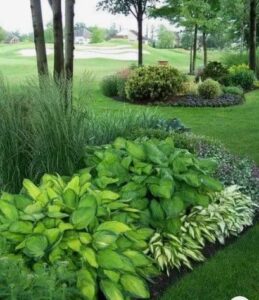Hosta gardens offer a variety of options for creating a peaceful and green oasis in shady areas. Different types of hosta plants can be combined to create interesting patterns and placed strategically for best growth.
Taking good care of these shade-loving plants can result in a beautiful garden that invites you to explore.
Key Takeaways
- Choose hostas with different leaf shapes, sizes, and colors for a cool garden look.
- Plant hostas in shady spots for them to grow well.
- Mix various hosta types in color, size, and texture for a lively garden.
- Make sure to space each hosta properly for healthy growth.
- Water hostas often and use mulch to keep the soil moist and prevent weeds.
Hosta Garden Design Basics
When designing a hosta garden, choose hostas with different leaf shapes, sizes, and colors for a beautiful landscape. Hostas like shade and can grow well in shady areas where other plants might struggle. Their wide leaves come in various colors, from dark greens to patterns with different colors, making your garden look interesting.
To design a hosta garden, pick hostas that go well together in terms of leaf characteristics. Plant them in groups to create a unified look, or line borders with different varieties to add texture and depth. Make sure each hosta has enough space to grow without crowding others. By placing hostas with diverse leaf colors and textures in your garden, you can create a cohesive and attractive display that thrives in shady spots.
Selecting Complementary Hosta Varieties
To make your hosta garden look nice, pair different hosta types that go well together in color, size, and texture. Mix blue hostas with yellow or gold ones for a cool contrast. Make sure to pick hostas that will grow to the right size and have different leaf textures for a balanced look.
Combining hostas with different patterns can make shady spots more interesting. Also, mix big, medium, and small hostas to create a diverse garden bed. Choose hostas that like the amount of sun or shade in your garden to keep them healthy and colorful.
Proper Placement for Hostas
Plant your hostas in areas with morning sun and afternoon shade for optimal health.
Ensure the soil drains well to avoid root rot.
Add companion plants that complement hostas for a beautiful garden.
Ideal Light Conditions
Hostas need 3 to 6 hours of morning sun in shaded areas for best growth and color. They like shade but do well with some morning sunlight for vibrant leaves and strong growth.
Partial shade helps prevent leaf burning and supports healthy development. Hostas can adapt to different light levels, from full shade to almost full sun.
Balancing light exposure will help your hostas thrive and make your garden look beautiful with their lush leaves.
Consider Soil Moisture
Hostas need moist, well-draining soil to grow well. They love shade but make sure the soil is always moist to avoid problems like leaves getting burnt or wilted.
In hot summers, it’s important to keep the soil moist for the hostas to stay healthy. Check if the soil drains well to prevent root rot. Adding compost can help improve the soil and retain water.
Companion Plants for Contrast
To make your hosta garden more beautiful, plant ferns, heucheras, or astilbes alongside them. Putting hostas near plants with large, bold leaves creates an interesting look.
Try mixing hostas with Japanese painted ferns or ligularias for a vibrant contrast. Pairing hostas with bleeding hearts or foamflowers can give your shade garden a balanced mix of colors.
To add variety, place hostas next to plants with different leaf shapes and sizes. This mix of hostas and companion plants will make your garden look great and lively.

Essential Hosta Care Practices
To keep your hosta plants healthy, water them 2-3 times a week. They need at least one inch of water weekly.
Plant large hostas 30-36 inches apart, medium ones 18-24 inches apart, and small ones 12-18 inches apart. Divide your hostas in spring or fall to make new plants and keep them vigorous.
Use well-drained soil with humus for alkaline soil types. Mulch with bark or pine needles to keep soil moist and prevent weeds.
These steps will help your hosta garden thrive.
Watering and Mulching Tips
Watering your hostas 2-3 times a week is ideal, ensuring they receive at least one inch of water weekly. Avoid watering from above to prevent slug problems.
To maintain moisture and protect the roots, apply a 2-3 inch layer of mulch around your hostas. This not only keeps the soil moist but also helps prevent weed growth.
Proper Watering Techniques
To keep your hostas healthy, water them 2-3 times a week in the growing season. Give them at least one inch of water each week for best results. Hostas need consistently moist soil, especially in sunny spots, to stay happy and grow well. Don’t water from above to avoid attracting slugs that can harm your plants.
Proper watering keeps the soil moist and supports your hostas’ overall health. Remember, a well-watered plant is a happy plant, so stick to your watering routine for a thriving hosta garden.
Let’s now talk about how mulching can make your hostas even happier.
Benefits of Mulching
Mulching around your hostas has multiple benefits. It helps keep the soil moist, reduces the need for frequent watering, and keeps your hostas hydrated for healthy leaves and strong growth. The mulch also acts as a blanket, protecting the roots from extreme temperatures and frost during winter.
It stops weeds from growing, keeping your hosta garden neat. Furthermore, mulch prevents soil erosion and compaction, which are good for your hostas’ overall health. So, remember to mulch your hostas for happy plants and a lovely garden!
Division Techniques for Healthy Hostas
To keep your hostas healthy, you should split them every 2-3 years. Here’s how to do it right:
- Gently separate: When dividing hostas, carefully pull the clumps apart to protect the roots.
- Use a sharp knife: A sharp knife helps divide hostas cleanly, which helps them heal faster and lowers the risk of diseases.
- Good soil: Plant the divided hostas in soil with lots of nutrients to help them grow well.
- Pick the right time: Divide hostas in early spring or fall for the best chance of success.
Protecting Hostas Against Garden Pests
To protect your hostas from pests, you can employ several strategies:
- Use diatomaceous earth for slugs.
- Plant deer-resistant hosta varieties.
- Use insecticidal soap for aphids.
- Keep an eye out for snails too, as they can harm hostas.
Where to Find Unique Hosta Varieties
When looking for unique hosta varieties, check out specialty nurseries, botanical gardens, and online hosta retailers for a wide selection. You can find special hostas by:
- Hybridizers and Collectors: Talk to people who specialize in rare and exclusive hosta types to get some unique additions for your garden.
- Hosta Conventions and Garden Shows: Visit these events to see a variety of unique hostas from different vendors.
- Online Forums and Groups: Join online communities focused on hosta plants to discover rare varieties and get helpful tips.
- Local Plant Sales and Auctions: Keep an eye out for unique hosta plants at local sales and auctions to enhance your garden’s beauty.
Frequently Asked Questions
How Do You Grow Lush Hostas?
To grow healthy hostas in your shaded garden, water them once a week, use nutrient-rich soil, prune them regularly, and keep pests away. Make sure to space them out properly for good airflow.
How Do You Grow Hostas in Shade?
To keep hostas happy in the shade, make sure to give them moist soil, occasional fertilizer, and keep an eye out for pests. Pair them with plants that get along well to create a beautiful garden. By taking care of them properly, you’ll have vibrant hostas in your shady garden oasis.
What Is the Best Hosta for Heavy Shade?
For heavy shade, consider ‘Francee’, ‘Sum and Substance’, ‘Blue Angel’, ‘Guacamole’, and ‘Night Before Christmas’ hostas.
What Does Coffee Grounds Do for Hostas?
Coffee grounds are great for hostas because they provide nutrients, adjust soil acidity, keep pests away, and keep the soil moist. Just remember not to use too much to avoid harming your hostas. Use coffee grounds wisely for healthy hostas.
Conclusion
To create a beautiful hosta garden in shady areas, choose different types of hosta plants that go well together. Place them where they can get enough shade, and remember to water them regularly. Use mulch to keep the soil moist and divide the plants when they get too crowded.
By doing these things, your hostas will stay healthy and look great all season long. With some care and attention, your shady garden will be filled with lush green leaves and colorful blooms, making it a lovely addition to your outdoor space.











